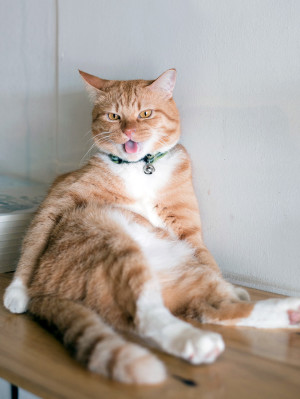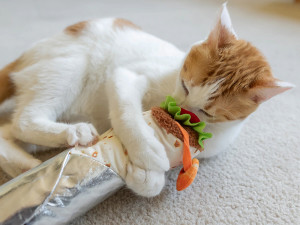Don’t Come For Us, But Is Your Cat Overweight?
We love a chonky cat, but here’s what you should know

share article
Meal prepping may give you a sense of control in a chaotic world, but when your cat gives you that food is love look you can’t help but cave and dole out the tuna treats with abandon. While there can never be too much cat, there can be too many vet billsopens in a new tab. In 2022, it was estimated that 53 percent of catsopens in a new tab were overweight or obese in the UK. And those extra pounds are associated with outsize issues including osteoarthritis, heart disease and diabetes.
How heavy should your cat be?
“Sometimes owners have difficulty recognising that their cats are overweight,” says Dr Bruce Kornreich, director of the Cornell Feline Health Center. Although the average cat weighs around 4.5kg, a Maine Coon is significantly heavier than a Siamese cat. This is why veterinarians don’t use a scale, but rather, rely on a visual assessment or Body Condition Scoring Systemopens in a new tab (BCS), which ranks from one to five – three being considered the ideal weight. As such, your cat would have an hourglass figure with a visible waist and an abdominal ‘tuck’ where their belly meets their hips. While cats with visible vertebrae are considered underweight, cats with an ‘obvious rounding of the abdomen’ (rude!) may need to start counting their macros.
How to help an obese cat lose weight
If you’re not convinced, a 2020 studyopens in a new tab titled, “Positive attitudes towards feline obesity are strongly associated with ownership of obese cats” might be on to something. Busted? Don’t worry – you’ve got a plan. Indoor cats with 24/7 access to food-filled bowls are more likely to be overweight, so close the buffet, start a feeding schedule, portion out meals and cut back on treats. Your vet can create a tailored weight reduction plan or write a prescription for a low-calorie diet, if needed.
Don’t expect your kitty to drop weight overnight, either. The poor thing has an unfairly slow metabolism. “The amount of weight your cat loses will vary depending on their food intake and activity level,” says Dr Kornreich, who suggests setting a weight loss goal of 0.5 to two percent of body weight per week. “Slow weight loss can be frustrating for cat owners but losing weight too fast could cause metabolic problems.”
Your cat may also need to start exercising. If your cat can go outside, make sure they’re getting out as much as possible, even if it’s just chasing some kicker toysopens in a new tab round the garden. There are also lots of motion-activatedopens in a new tab cat toys, climbing towersopens in a new tab and interactive puzzle feeders on the market to get your cat moving. If all else fails, we’ve never met a cat who didn’t love an old-school laser pointer.

Jodi Helmer
Jodi Helmer is a North Carolina-based freelance writer who shares her home with an embarrassing number of rescue dogs and relies on four feral cats to patrol the barn. When she isn’t refilling food and water dishes, Jodi writes about animals for Scientific American, Sierra, WebMD, AKC Family Dog, Living the Country Life, and Out Here.
Related articles
![Cat laying inside a cat tree]() opens in a new tab
opens in a new tabCat Trees That Won’t Clash With Your Aesthetic
Stylish cat trees for every home and personality, from cartoon flowers to modernist towers
![White and tan cat playing with a taco toy]() opens in a new tab
opens in a new tab10 Food-Themed Toys to Tease Your Cat
From burritos to baguettes, these catnip-stuffed toys may curb your cat’s munchies
![cat with interactive carrot puzzle toy]() opens in a new tab
opens in a new tabThis Plush Carrot Puzzle Toy Will Satisfy Your Food-Motivated Cat
Finally, something engaging to distract them from real food
![Three cat puzzles on a colorful pink, burgundy, and green color-block background]() opens in a new tab
opens in a new tabThe Best Puzzles to Unleash Your Cat’s Inner Einstein
Genius takes many forms. Could your cat be one?
![cat in a follow tv]() opens in a new tab
opens in a new tabWait, This Is Cat Furniture?
Mid-century modern coffee table or litter box? Industrial bookcase or cat tower? If you can’t tell, that’s kind of the point





